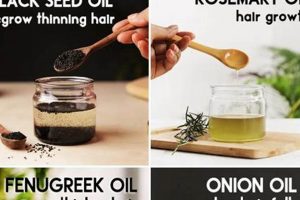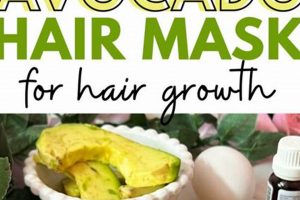A concoction crafted at home, utilizing natural oils, vitamins, and extracts believed to stimulate follicles and promote increased hair length and thickness, represents a cost-effective and customizable approach to hair care. For instance, combining rosemary, lavender, and cedarwood essential oils with a carrier oil like jojoba and applying it directly to the scalp is a common formulation.
The appeal of these preparations stems from the potential to control ingredients, avoiding harsh chemicals often found in commercial products. The perceived benefits include a healthier scalp environment, reduced hair breakage, and enhanced circulation. Historically, plant-based remedies have played a significant role in hair care practices across various cultures, making the concept of creating one’s own treatment deeply rooted in tradition.
The following sections will delve into the specific ingredients commonly used in these homemade solutions, methods of preparation and application, safety precautions to consider, and the scientific evidence, or lack thereof, supporting their purported efficacy.
Application Strategies for Scalp Treatments
Maximizing the potential of homemade preparations requires careful consideration of ingredient selection, preparation, and application techniques.
Tip 1: Begin with a patch test. Apply a small amount of the mixture to a discrete area of skin, such as the inner arm, to assess for allergic reactions or irritation before widespread application to the scalp.
Tip 2: Use high-quality, cold-pressed carrier oils. These oils retain more nutrients and antioxidants compared to refined oils, potentially offering greater benefit to the scalp and hair follicles. Examples include jojoba, argan, and grapeseed oil.
Tip 3: Dilute essential oils appropriately. Essential oils are highly concentrated and can cause skin irritation if applied undiluted. A general guideline is to use a 1-3% dilution, meaning 1-3 drops of essential oil per teaspoon of carrier oil.
Tip 4: Massage the preparation thoroughly into the scalp. Gentle massage can improve blood circulation to the hair follicles, potentially promoting increased nutrient delivery and stimulating growth.
Tip 5: Apply the treatment consistently. For optimal results, incorporate the homemade treatment into a regular hair care routine. Consistency is key, and noticeable improvements may take several weeks or months of regular application.
Tip 6: Monitor the scalp for any adverse reactions. Discontinue use immediately if any signs of irritation, redness, or itching occur.
Tip 7: Protect clothing and bedding during application and while the treatment is processing. Oils can stain fabrics; therefore, precautions should be taken to avoid unwanted discoloration.
Adherence to these strategies, including the importance of safety testing and consistent application, is crucial when integrating scalp treatments into a hair care regimen. By adopting a diligent and mindful approach, individuals can maximize the potential benefits while minimizing the risk of adverse reactions.
The subsequent section will explore potential ingredients and their purported benefits, further expanding on how to formulate personalized treatments.
1. Ingredient Selection
Ingredient selection represents the cornerstone of formulating any effective homemade scalp treatment intended to promote hair development. The specific components chosen dictate the potential efficacy, safety profile, and suitability for individual needs. Prudent selection based on scientific understanding, historical use, and individual sensitivity is paramount.
- Carrier Oils and Nutrient Delivery
Carrier oils such as jojoba, argan, and grapeseed serve as the base of the formulation, facilitating the absorption of other active ingredients. They also contribute essential fatty acids and vitamins that nourish the scalp and hair follicles. The selection of carrier oil should align with individual hair type and scalp condition. For example, individuals with oily scalps may prefer lighter oils like grapeseed, while those with dry scalps may benefit from richer oils like argan.
- Essential Oils and Bioactive Compounds
Essential oils, derived from plant extracts, contribute targeted bioactive compounds. Rosemary oil, for example, is purported to enhance circulation to the scalp, while lavender oil may possess anti-inflammatory properties. The concentration of essential oils must be carefully controlled to avoid irritation. The selection of essential oils should be based on their documented properties and potential synergistic effects.
- Herbal Infusions and Traditional Remedies
The incorporation of herbal infusions, using herbs such as horsetail or nettle, can introduce minerals and antioxidants traditionally associated with hair strengthening. The preparation method of these infusions impacts the concentration of active compounds. Historical use and anecdotal evidence often guide the selection of herbs; however, scientific validation remains crucial.
- Preservatives and Shelf Life Considerations
In homemade formulations, preservatives are often absent, limiting shelf life and increasing the risk of microbial contamination. Ingredient selection should, therefore, prioritize fresh, high-quality components. Storage conditions, such as refrigeration, can extend the usable life of the product. The absence of preservatives necessitates frequent preparation of small batches to maintain efficacy and safety.
The careful consideration of these aspects of ingredient selection directly influences the success, or failure, of a homemade preparation intended to stimulate hair development. The chosen components must work synergistically to nourish the scalp, promote circulation, and deliver bioactive compounds while minimizing the risk of adverse reactions and maintaining product stability.
2. Preparation Method
The preparation method significantly influences the efficacy and safety profile of any homemade formulation designed to stimulate hair development. Variations in technique impact the concentration, stability, and bioavailability of active compounds derived from the selected ingredients. A standardized and informed approach is therefore essential.
- Infusion Techniques and Compound Extraction
The method of infusing herbs or other plant-based ingredients directly affects the extraction of bioactive compounds. Aqueous infusions, such as teas, extract water-soluble components, while oil-based infusions draw out lipid-soluble compounds. The choice of solvent, temperature, and duration of infusion determines the spectrum and concentration of compounds released. For example, prolonged heating may degrade volatile oils, reducing their therapeutic benefit.
- Blending and Emulsification Procedures
The blending of carrier oils and essential oils requires precise techniques to ensure even distribution and stability. Simple mixing may result in phase separation, reducing the uniform application of active ingredients to the scalp. Emulsification, using natural emulsifiers like lecithin, can improve the miscibility of oil and water-based components, resulting in a more homogenous product. This is particularly relevant when incorporating water-based extracts or hydrosols into oil-based formulations.
- Sterilization and Contamination Prevention
Homemade formulations lack the rigorous sterilization processes employed in commercial production. Consequently, contamination with bacteria or fungi poses a significant risk. Proper sanitation of equipment, including thorough washing and sterilization of containers, is paramount. The use of distilled water and freshly prepared ingredients minimizes the introduction of contaminants. Furthermore, storage in airtight, sterilized containers under cool conditions reduces microbial growth.
- Dosage Precision and Dilution Ratios
The accurate measurement of ingredients, particularly essential oils, is crucial for safety. Essential oils are highly concentrated and can cause skin irritation or sensitization if applied undiluted. Precise measurement tools, such as calibrated pipettes or syringes, are necessary to achieve the recommended dilution ratios. Inaccurate measurements can lead to either ineffective formulations or adverse reactions. A standardized approach to dosage and dilution ensures consistent results and minimizes risks.
The preparation method is not merely a procedural step but a critical determinant of the final product’s quality and efficacy. Proper techniques ensure optimal extraction, stability, and safety, maximizing the potential benefits of the hair growth serum while minimizing potential risks associated with contamination or improper dosage.
3. Application Frequency
Application frequency is a pivotal determinant of the effectiveness of homemade hair preparations. The intervals at which these formulations are applied to the scalp directly influence the bioavailability of active ingredients and the cumulative stimulation of hair follicles. A haphazard or inconsistent application schedule compromises potential benefits, rendering even meticulously crafted preparations less effective.
For instance, a serum containing rosemary oil, known for its purported circulation-boosting properties, may demonstrate limited impact if applied only sporadically. Regular, consistent application, typically ranging from several times per week to daily, ensures sustained exposure of the follicles to the active compounds. This consistency is crucial for maintaining a stimulated scalp environment conducive to hair growth. The optimal frequency, however, is contingent upon individual scalp sensitivity, the concentration of active ingredients, and the specific goals of the treatment.
The balance between therapeutic benefit and potential scalp irritation necessitates careful consideration. Excessive application, particularly of formulations containing potent essential oils, can lead to adverse reactions such as dermatitis or inflammation. Conversely, infrequent application may fail to deliver a sufficient dose of active ingredients to elicit a noticeable response. Therefore, a structured application schedule, tailored to individual needs and monitored for any signs of irritation, is essential for realizing the full potential of homemade hair preparations.
4. Scalp Sensitivity
Scalp sensitivity significantly influences the formulation and application of homemade preparations designed to promote hair development. The scalp’s inherent susceptibility to irritation dictates the selection of ingredients, dilution ratios, and application frequency. Failure to account for individual scalp sensitivity can lead to adverse reactions that undermine the intended benefits of the treatment.
- Ingredient Selection and Irritant Potential
The composition of a homemade preparation directly impacts the likelihood of triggering scalp sensitivity. Certain essential oils, such as tea tree or peppermint, known for their potent properties, can irritate sensitive scalps if used in high concentrations. Similarly, carrier oils containing comedogenic properties may exacerbate pre-existing conditions like seborrheic dermatitis. Therefore, the formulation process requires careful consideration of the irritant potential of each ingredient and the avoidance of known allergens.
- Dilution Ratios and Concentration Thresholds
Dilution ratios play a crucial role in mitigating the risk of irritation. Essential oils must be diluted in a suitable carrier oil to reduce their concentration to a safe threshold for the individual’s scalp. Individuals with highly sensitive scalps may require significantly lower concentrations compared to those with normal scalps. Careful titration and patch testing are essential to determine the appropriate dilution ratio that balances therapeutic efficacy with minimal irritation.
- Application Frequency and Cumulative Exposure
The frequency of application also impacts the cumulative exposure of the scalp to potentially irritating compounds. Daily application, even of mildly irritating ingredients, can lead to sensitization over time. Conversely, less frequent application may allow the scalp to recover between treatments. The optimal application frequency should be determined based on individual tolerance and the severity of any observed reactions.
- Patch Testing and Sensitivity Assessment
Prior to widespread application, a patch test should be performed to assess individual sensitivity. Applying a small amount of the preparation to a discrete area of skin, such as the inner arm, and monitoring for any signs of irritation (redness, itching, burning) provides valuable information about potential reactions. A negative patch test does not guarantee the absence of irritation, but it serves as a preliminary indicator of tolerance.
The relationship between scalp sensitivity and the effectiveness of homemade hair preparations is undeniable. Formulations must be carefully tailored to individual needs, considering ingredient selection, dilution ratios, application frequency, and the results of patch testing. A proactive approach to minimizing irritation is essential for maximizing the benefits of these treatments and ensuring scalp health.
5. Desired Outcome
The envisioned result serves as the guiding principle in formulating and applying a homemade preparation intended to stimulate hair development. The clarity and specificity of the desired outcome dictate the selection of ingredients, the preparation method, and the application frequency. Vague or unrealistic expectations often lead to dissatisfaction and potentially harmful practices.
- Increased Hair Density
Increased hair density, often perceived as thicker or fuller hair, is a common objective. Formulations targeting this outcome typically incorporate ingredients believed to stimulate follicle activity and promote the growth of new hair strands. Examples include rosemary oil, which is thought to enhance circulation to the scalp, and saw palmetto extract, which may inhibit the conversion of testosterone to dihydrotestosterone (DHT), a hormone associated with hair thinning. The success of formulations aimed at increasing density is dependent on factors such as genetic predisposition and the underlying cause of hair thinning.
- Accelerated Hair Length
The desire for rapid hair elongation drives the use of formulations purported to stimulate hair growth rate. Ingredients like biotin, a B-vitamin essential for cell growth, and horsetail extract, rich in silica, a mineral that supports collagen production, are frequently incorporated. The actual impact on growth rate may be modest and varies among individuals. Factors such as genetics, diet, and overall health play a more significant role in determining hair length than topical applications alone.
- Reduced Hair Shedding
Minimizing excessive hair shedding is another frequently cited objective. Preparations targeting this outcome often include ingredients with anti-inflammatory or antioxidant properties. For example, green tea extract is thought to reduce inflammation on the scalp, while vitamin E oil provides antioxidant protection. Reducing hair shedding may require addressing underlying causes such as stress, hormonal imbalances, or nutritional deficiencies in addition to topical treatments.
- Improved Hair Health and Appearance
Enhanced hair health, manifested as increased shine, reduced breakage, and improved manageability, represents a more holistic desired outcome. Formulations designed to achieve this typically include nourishing carrier oils like argan or coconut oil, which moisturize and protect the hair shaft. While not directly stimulating hair growth, these oils can improve the overall appearance and condition of the hair, indirectly contributing to the perception of healthier, more vibrant hair.
The articulation of a clear and realistic desired outcome is essential for guiding the formulation and application of any homemade scalp treatment. This articulation enables individuals to make informed choices about ingredients, preparation methods, and application frequencies, maximizing the potential for positive results and minimizing the risk of disappointment or adverse effects. Further exploration of the “Storage Stability” facet can augment the understanding and application of these DIY approaches.
6. Storage Stability
Storage stability, the ability of a formulation to retain its properties and efficacy over time, is a critical yet often overlooked aspect of homemade hair preparations. Unlike commercially manufactured products, these DIY treatments typically lack synthetic preservatives and stabilizers, rendering them more susceptible to degradation from environmental factors such as light, heat, and oxidation. Consequently, the bioactive compounds intended to stimulate hair development may diminish or become altered, leading to a reduction in potency or even the formation of harmful byproducts. For example, essential oils, prized for their therapeutic properties, are volatile and can evaporate or undergo oxidation when exposed to air and light, diminishing their intended benefits and potentially causing skin irritation. Improper storage can also foster microbial growth, compromising the safety and efficacy of the preparation. The cause-and-effect relationship between storage conditions and product integrity is direct and significant.
The selection of appropriate storage containers is fundamental to maintaining the stability of these preparations. Opaque, airtight glass bottles are preferred over plastic containers, as they minimize exposure to light and oxygen and prevent the leaching of plastic compounds into the formulation. Refrigeration can further extend shelf life by slowing down degradation reactions and inhibiting microbial growth. However, some oils may solidify at lower temperatures, requiring gentle warming before use. Labeling containers with the date of preparation allows for tracking the product’s age and ensures that it is discarded after a reasonable period, typically ranging from a few weeks to several months, depending on the ingredients used. Real-life examples abound: A batch of oil stored in clear plastic on a sunny windowsill quickly turns rancid, while a similar batch kept in a dark glass bottle in the refrigerator retains its scent and texture for a significantly longer duration. This demonstrates the tangible impact of storage practices.
In conclusion, storage stability is not merely a peripheral concern but an integral component of any successful homemade hair development strategy. The absence of synthetic preservatives necessitates diligent attention to storage practices to preserve the integrity and efficacy of the preparation. By selecting appropriate containers, controlling temperature and light exposure, and tracking the product’s age, individuals can maximize the benefits of these DIY treatments and minimize the risk of adverse reactions. These practices are essential for translating the initial effort invested in formulation into tangible and sustainable improvements in hair health.
Frequently Asked Questions
This section addresses common inquiries regarding the formulation, application, and efficacy of homemade topical treatments intended to stimulate hair development. The information provided is intended for educational purposes and does not constitute medical advice. Consult with a healthcare professional before initiating any new hair care regimen.
Question 1: How can one ascertain the safety of a “hair growth diy serum” before widespread use?
Prior to applying any homemade formulation to the entire scalp, a patch test is essential. A small amount of the serum should be applied to a discrete area of skin, such as the inner arm or behind the ear, and observed for 24-48 hours for any signs of adverse reaction, including redness, itching, or swelling. A negative reaction does not guarantee the absence of sensitivity, but it provides a preliminary indication of tolerability.
Question 2: What is the typical shelf life of a “hair growth diy serum” and how does one maximize its longevity?
The shelf life of a homemade serum is inherently limited due to the absence of synthetic preservatives. Typically, these preparations remain viable for 1-3 months when stored properly. To maximize longevity, the serum should be kept in a dark glass bottle, tightly sealed, and stored in a cool, dark location, preferably in the refrigerator. Exposure to light, heat, and air accelerates degradation and microbial growth.
Question 3: Are there specific contraindications or conditions under which a “hair growth diy serum” should be avoided?
Certain pre-existing scalp conditions, such as seborrheic dermatitis, psoriasis, or active infections, may be exacerbated by topical applications. Individuals with these conditions should consult with a dermatologist before using a homemade serum. Additionally, pregnancy, breastfeeding, and certain medical conditions may necessitate the avoidance of specific ingredients, particularly essential oils.
Question 4: What carrier oils are most suitable for different hair types in a “hair growth diy serum?”
The selection of a carrier oil should align with individual hair type and scalp condition. Jojoba oil is versatile and suitable for most hair types, mimicking the scalp’s natural sebum. Grapeseed oil is lightweight and beneficial for oily scalps. Argan oil is rich and nourishing, ideal for dry or damaged hair. Coconut oil, while moisturizing, can be comedogenic for some individuals.
Question 5: How frequently should a “hair growth diy serum” be applied for optimal results?
The optimal application frequency varies based on individual tolerance and the potency of the serum. A common recommendation is to apply the serum 2-3 times per week. Daily application may be appropriate for some individuals but can increase the risk of irritation. It is crucial to monitor the scalp for any signs of adverse reaction and adjust the frequency accordingly. Consistency is paramount, and noticeable results may require several weeks or months of regular application.
Question 6: What essential oils should be avoided when formulating a “hair growth diy serum” due to potential toxicity or allergenicity?
Certain essential oils, such as pennyroyal, rue, and wintergreen, should be avoided due to their potential toxicity. Other oils, including cinnamon, clove, and citrus oils, can be irritating or allergenic for sensitive individuals. Thorough research and careful consideration of individual sensitivities are essential when selecting essential oils for a homemade serum.
These responses highlight the importance of careful consideration, diligent application, and individual awareness when utilizing homemade preparations for hair development. The selection of appropriate ingredients, adherence to safety protocols, and consistent application are essential for maximizing potential benefits and minimizing the risk of adverse effects.
The following section will delve into the limitations and potential drawbacks associated with homemade hair treatments.
Conclusion
The preceding exploration has elucidated various facets of hair growth diy serum. From ingredient selection and preparation methods to application frequency and storage stability, each element demands careful consideration. The absence of stringent quality control measures inherent in commercial products necessitates heightened vigilance in homemade formulations. The potential benefits of customized ingredients and cost-effectiveness are counterbalanced by the risks of contamination, instability, and adverse reactions if proper protocols are not diligently followed.
Therefore, while the allure of a personalized hair growth solution is undeniable, individuals must approach these preparations with a clear understanding of both their potential and limitations. Continuous evaluation of the scientific evidence supporting the efficacy of individual ingredients, coupled with a commitment to safety and informed practices, is essential. Further research is needed to validate the anecdotal claims surrounding many natural hair growth remedies. A responsible and informed approach will ensure the potential benefits of hair growth diy serum are realized while mitigating potential risks.







